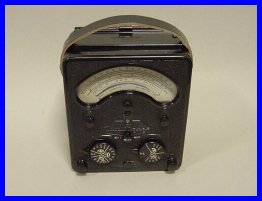          |
It was important
that the machinery at the plant was kept in working order and one piece
of equipment used to test the machinery was the AVO meter.
 |
So can you explain
what AVO meters do?
An AVO meter is just a straightforward volt meter, a sort of combination
meter similar to the electric ones that they have today, just mechanical.
So could you
describe one these AVO meters please.
Basically an
AVO meter was a black box with a dial, and a pointer which measured
voltage in a variety of ranges. It measured current and it also
measured resistance. It was a general meter that would do almost
any job.
And what size
was it?
It would be
about six inches square possibly, by about 4 inches deep.
And made out
of?
They were always
bakelite funnily enough, they were black bakelite. There were others
by other companies that were in wooden boxes. It was quite common
to have them in wooden boxes.
(Maurice
Bailey)
|

An example of
an AVO meter
However, not everybody
had equipment that was as sophisticated. Roy Beeken describes his 'homemade'
testing eqiupment.
|

|
A machine would
breakdown and you would test it with your antiquated testing equipment
which was home made. That would be a magneto bell from an old telephone
in a wooden box with two wires attached to it. You'd turned the
handle and if the circuit was there it would ring the bell, and
if it wasn't there it was an open circuit and the bell wouldn't
ring. We had no AVOs, no testing equipment as such, and to test
for live equipment we used to make up three lamps in series, two
wires and just put things across the live wires and if they lit
up it was live and if it didn't it was dead.
(Roy Beeken)
|
|

